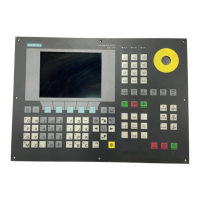Detailed Description
2.9 Mode group, channel, program operation, reset response (K1)
NC/PLC Interface Signals (Z1)
Function Manual, 08/2005 Edition, 6FC5397-0BP10-0BA0
2-83
DB11, ...
DBX0.7
Mode group reset
Corresponding to .... DB21, ... DBX7.7 (channel reset)
DB11, ... DBX6.7 (all channels in the reset state)
Special cases,
errors, ......
An alarm which cancels the interface signal
DB11, ... DBX6.3 (mode group ready)
ensures that all of the channels of the mode group are no longer in the reset state.
In order to switch to another operating mode, a mode group reset (DB11, ... DBX0.7) must then be
initiated.
DB11, ...
DBX1.0
Machine function TEACH IN
Edge evaluation: no Signal(s) updated: cyclic
Signal state 1 or
edge change
0 → 1
Machine function TEACH IN is activated in JOG mode for the mode group.
Signal state 0 or
edge change
1 → 0
Machine function TEACH IN is not activated.
Signal irrelevant
for ...
If JOG mode is not active.
Additional references /BA/ Operator's Guide
DB11, ...
DBX1.1
Machine function REPOS
Edge evaluation: no Signal(s) updated: cyclic
Signal state 1 or
edge change
0 → 1
Machine function REPOS is activated in JOG mode for the mode group.
Signal state 0 or
edge change
1 → 0
Machine function REPOS is not activated.
Signal irrelevant
for ...
JOG mode is not active.
Application
example(s)
When a fault occurs when executing a part program (e.g. tool breakage), the axis is manually
moved away from the fault location in the JOG mode in order to be able to replace the tool.
The axis can then be manually returned to the precise previous position using the REPOS machine
function so that the program can be continued in the automatic mode.
Additional references /BA/ Operator's Guide

